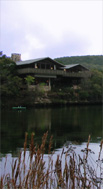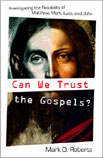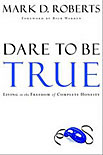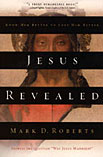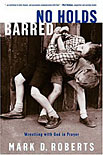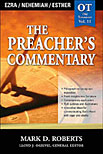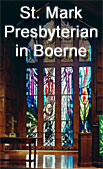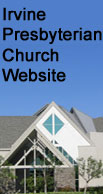My blog has moved! http://www.patheos.com/blogs/markdroberts/
|
 |
Twitter Feed for My Recent Blog Posts and Other Tweets |
My blog has moved! http://www.patheos.com/blogs/markdroberts/
|
The Temple as a Thin Place
By Mark D. Roberts | Friday, May 15, 2009
Part 5 of series: Thin Places
Permalink for this post / Permalink for this series
After God established the Tabernacle as “sanctuary” for the Israelites so that he might “dwell in their midst” (Exod 25:8), he continued to “camp” among his people in a temporary, portable dwelling. Many generations passed, until David became the king of God’s people and centered his kingdom in Jerusalem. One day it dawned on David that he lived in a luxurious palace while the Lord only had a tent. So David resolved to build a permanent “house” for the Lord, a temple in Jerusalem.
At first, God did not seem too keen on the idea:
I have not lived in a house since the day I brought up the people of Israel from Egypt to this day, but I have been moving about in a tent and a tabernacle. Wherever I have moved about among all the people of Israel, did I ever speak a word with any of the tribal leaders of Israel, whom I commanded to shepherd my people Israel, saying, “Why have you not built me a house of cedar?” (2 Sam 7:6-7)
Nevertheless, the Lord choose, not David, but his son Solomon to “build a house for my name” (2 Sam 7:13).
This “house,” the Temple built in Jerusalem, was often referred to as God’s house, the place where he lived. For example:
For the LORD has chosen Zion;
he has desired it for his habitation:
“This is my resting place forever;
here I will reside, for I have desired it.” (Ps 132:13)
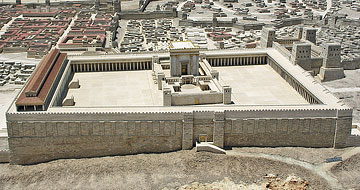 Yet the Jewish people understood that the Lord did not literally live in the Temple. At its dedication, when the glory of the Lord filled the temple, Solomon said, “The LORD has said that he would dwell in thick darkness. I have built you an exalted house, a place for you to dwell in forever” (1 Kings 8:12-13). But then, several verses later, Solomon adds, “But will God indeed dwell on the earth? Even heaven and the highest heaven cannot contain you, much less this house that I have built! . . . Hear the plea of your servant and of your people Israel when they pray toward this place; O hear in heaven your dwelling place; heed and forgive (1 Kings 8:27, 30). (Photo: A model of the Temple, now at the Israel Museum in Jerusalem.)
Yet the Jewish people understood that the Lord did not literally live in the Temple. At its dedication, when the glory of the Lord filled the temple, Solomon said, “The LORD has said that he would dwell in thick darkness. I have built you an exalted house, a place for you to dwell in forever” (1 Kings 8:12-13). But then, several verses later, Solomon adds, “But will God indeed dwell on the earth? Even heaven and the highest heaven cannot contain you, much less this house that I have built! . . . Hear the plea of your servant and of your people Israel when they pray toward this place; O hear in heaven your dwelling place; heed and forgive (1 Kings 8:27, 30). (Photo: A model of the Temple, now at the Israel Museum in Jerusalem.)
For Jews, the Temple represented God’s presence with them. Going to the Temple was a solemn occasion for prayer and sacrifices, but also a joyous occasion for celebration and feasting. Of course, only priests were able to enter the actual sanctuary, with its Holy Place and Most Holy Place (literally translated from Hebrew as “holy of holies”). In fact, the high priest alone was able to enter the Most Holy Place, and only once a year, on the Day of Atonement.
The Temple represented the Lord’s unique covenant relationship with Israel. He was their God and they were his people. By the time of Jesus, the Temple in Jerusalem, built by King Herod the Great, included several outer courts. The furthest out was the Court of the Gentiles. They were included, but kept out of the courts reserved only for Jews, including the inner sanctuary.
Yet, certain prophetic passages envision a time when the Gentiles would come to the Temple:
In days to come
the mountain of the LORD’S house
shall be established as the highest of the mountains,
and shall be raised up above the hills.
Peoples shall stream to it,
and many nations shall come and say:
“Come, let us go up to the mountain of the LORD,
to the house of the God of Jacob;
that he may teach us his ways
and that we may walk in his paths.”
For out of Zion shall go forth instruction,
and the word of the LORD from Jerusalem” (Micah 4:1-2).
Other prophetic texts shows that this is not just something the Gentiles desire, but something willed by the Lord himself:
And the foreigners who join themselves to the LORD,
to minister to him, to love the name of the LORD,
and to be his servants,
all who keep the sabbath, and do not profane it,
and hold fast my covenant—
these I will bring to my holy mountain,
and make them joyful in my house of prayer;
their burnt offerings and their sacrifices
will be accepted on my altar;
for my house shall be called a house of prayer
for all peoples.
(Isa 56:6-7)
Thus Jewish eschatology envisioned a day when all peoples, not just the Jews, would come to the Temple for prayer, sacrifices, instruction, and celebration.
Reflections on the Temple as a Thin Place
In Exodus, the possible thin places always seemed to be lacking something. Mt. Sinai was a very thin place, but only in unusual revelatory moments. The Pillars of Cloud and Fire and the Tabernacle were astounding space-time signs of God’s presence, but they weren’t places in the ordinary sense since they were intentionally portable.
The Temple in Jerusalem is a closer analogy to a thin place. It was one place and it didn’t move. This place was said to be God’s own house, though it was understood that God didn’t actually live there. The Temple helped people get right with God (through sacrifices) and be directed by God (through teaching) and communicate with God (through prayer) and enjoy God (through celebrations).
The Temple was not, however, a place of worship like a synagogue or church sanctuary. Nor was it a quiet place for retreat, at least not in the courts where ordinary folk were welcome. The Temple, by its very design, kept people away from its holiest places, the places where God was said to dwell and where priests alone could enter. Yet common people surely experienced God’s presence in the Temple courts, and in this sense they constituted a thin place. Thus people looked forward to coming to the Temple, as Psalm 84 reminds us:
How lovely is your dwelling place,
O LORD of hosts!
My soul longs, indeed it faints
for the courts of the LORD;
my heart and my flesh sing for joy
to the living God. . . .
For a day in your courts is better
than a thousand elsewhere.
I would rather be a doorkeeper in the house of my God
than live in the tents of wickedness. (Psalm 84:1-2, 10)
The existence of the Temple shows that God can and does, at times, identify closely with a certain place, making his presence known there in a powerful way. But this truth is reshaped in light of Christ. I’ll explain further in my next post in this series.
Topics: Thin Places | 2 Comments »
More Thin Places in Exodus
By Mark D. Roberts | Thursday, May 14, 2009
Part 4 of series: Thin Places
Permalink for this post / Permalink for this series
In my last post, I examined Mt. Sinai as a thin place, that is, a place where God is experienced with unusual propinquity. (Now there’s a word I haven’t used or even thought of in about thirty years. “Propinquity” means “proximity.” It is the state of being physically close to someone or something.) If ever there was a thin place, this would have to be Sinai, because that’s where God first revealed himself to Moses in the burning bush, and then made his presence known in forming the covenant and giving the law to Israel. Yet, as I mentioned at the end of my last post, we have no reason to believe that the Israelites continued to regard Sinai as a special place where they might experience God in a special way.
The Pillar of Cloud and the Pillar of Fire
 Other thin places in Exodus are similarly ambiguous with respect to their enduring thinness. After the Israelites began their journey from Egypt to the Promised Land, God led them by a pillar of cloud by day and a pillar of fire by night (Exod 13:21-22, for example). The text states that God was “in” the pillar in way that God is not ordinarily “in” the world. In fact, the Lord spoke to Moses from within the pillar (Exod 33:9). Once more, it would be hard to discount the thinness of these pillars, but, although they take up space in the world, they don’t inhabit one particular place. At best, one might say they are moving thin places. (Photo: Tintoretto, “The Pillar of Fire,” 1577-1578)
Other thin places in Exodus are similarly ambiguous with respect to their enduring thinness. After the Israelites began their journey from Egypt to the Promised Land, God led them by a pillar of cloud by day and a pillar of fire by night (Exod 13:21-22, for example). The text states that God was “in” the pillar in way that God is not ordinarily “in” the world. In fact, the Lord spoke to Moses from within the pillar (Exod 33:9). Once more, it would be hard to discount the thinness of these pillars, but, although they take up space in the world, they don’t inhabit one particular place. At best, one might say they are moving thin places. (Photo: Tintoretto, “The Pillar of Fire,” 1577-1578)
The Tabernacle and Tent of Meeting
The Tabernacle dominates the latter portion of the Book of Exodus. It was a sanctuary for the Lord, a large, ornate, sophisticated tent structure. Because it was a tent, the Tabernacle was portable. It could move with the Israelites as they journeyed in the wilderness on their way to the Promised Land.
The Tabernacle, which was set up within a portable court, was itself divided into two sections. The larger section was the Holy Place, where various sacred items were housed. The smaller section was the Most Holy Place (traditionally, Holy of Holies), which contained the Ark of the Covenant. The Lord made his presence known in a unique and powerful way in the Most Holy Place.
Prior to the construction of the Tabernacle proper, which was sometimes called the “Tent of Meeting,” Moses had another, smaller Tent of Meeting in which he would meet with the Lord for personal conversation (Exod 33:7ff.). When the pillar of cloud descended on this Tent, the people would bow down to the ground, and the Lord would speak to Moses “face to face” (33:11).
When the official Tabernacle was consecrated, the Lord visited it in a most striking way. His glory filled the Tabernacle to such an extent that Moses was not able to enter it (Exod 40:34-36). The pillar of cloud and the pillar of fire rested upon the Tabernacle, signifying the powerful presence of God. The Israelites would remain in a given location until the pillar (or cloud) would be lifted from the Tabernacle as a sign that it was time to move on.
Reflections on the Pillars and Tents in Exodus
The Lord made himself known to his people in unusually immediate and sensational ways during the Exodus. In a way, the pillars of cloud and fire, and the Tents of Meeting (both Moses’ tent and the official Tabernacle), were exemplary thin places. Except for the fact that they weren’t places, strictly speaking. They were physical objects or realities that took up space and inhabited places, but didn’t remain in these places. What is perhaps most striking about these physical manifestations of God is their portability.
Yesterday, we noted that Mt. Sinai was a kind of thin place. God made his presence known there in an extraordinary way. But Sinai was not a thin place in the sense that it continued to be a portal to heaven in the eyes of the Jewish people. Today, we see thin places that aren’t quite places. For a while, the pillars and tents were space-time realities through which God revealed himself in certain places. But these manifestations were not stationary places.
Moreover, it’s worth remembering that God’s presence in a place did not necessarily make it hospitable, like a peaceful retreat center. When the Lord descended on Sinai with pyrotechnic splendor, the people were told to keep their distance, and that’s exactly what they wanted. And when God’s glory filled the Tabernacle, even Moses couldn’t enter it. When thin places get very thin, we might need to keep our distance.
The Book of Exodus suggests that God makes himself known to us in places and spaces, but that they are not stationary thin places were God’s presence can regularly be experienced. Nothing in Exodus denies the existence of such places stationary thin places. But nothing in Exodus commends them, either.
Of course, as the story of Israel progresses, the Tabernacle becomes replaced by the Temple, which exists in a solitary location. In my next post in this series I’ll consider ways in which the Temple might be an exemplary thin place.
Topics: Thin Places | 1 Comment »
Mt. Sinai as a Thin Place
By Mark D. Roberts | Wednesday, May 13, 2009
Part 2 of series: Thin Places
Permalink for this post / Permalink for this series
If a thin place is defined as a place where God’s presence is known with particular immediacy, then there are several stunning thin places in Exodus . . . sort of. As we’ll see, they don’t exactly seem to fit the definition, though they certainly are thin.
Moses and the Burning Bush at the Mountain of God
In Exodus 3, Moses was tending his father-in-law’s flock when he came to “Horeb, the mountain of God” (3:1; Mt. Horeb is more commonly known as Mt. Sinai). “There the angel of the LORD appeared to him in a flame of fire out of a bush; he looked, and the bush was blazing, yet it was not consumed” (v. 3). When Moses started to investigate, the LORD himself called to him and told him not to approach, but to take off his sandals “for the place on which you are standing is holy ground” (v. 5). As Moses stood there, God revealed his purpose (to free the Israelites from their bondage in Egypt) and his name (I AM WHO I AM; I AM; Yahweh; all versions of the Hebrew verb “to be”) (3:7-14).
The Covenant and the Law at the Mountain of God
After the Israelites were delivered from Egypt, they journey into the same wilderness where Moses once encountered God in the burning bush. They camped in front of the mountain of God in what is called “the wilderness of Sinai” (19:2). Moses ascended the mountain, where God spoke to him, initiating the covenant with Israel (19:3-6). On the third day after this encounter, the Lord descended upon the mountain with fire, thunder, lightening, and smoke (19:16-19). Once again, he spoke to Moses, though this time “in thunder” (19:19). The Lord warned the people, through Moses, not to approach the mountain because it was holy (19:23-25). Then, in this context, God spoke the Ten Commandments (20:2-17). The people were afraid of the natural phenomena on the mountain, and kept their distance. Only Moses drew near to God (20:18-21) to receive God’s laws.
One of God’s first instructions to the Israelites was to build for him “an altar of earth” so they might present their offerings upon it (20:24). Then the Lord adds, “in every place where I cause my name to be remembered I will come to you and bless you” (20:24). At this point, the Israelites are not to build only one altar, whether at Mt. Sinai or any other place. Rather, they are to build altars in various places. Moreover, God promises to come to them in these places.
Reflections on Mt. Sinai as a Thin Place
If ever there were a thin place, it would have to be Mt. Sinai. After all, there the Lord revealed his purpose and name to Moses, a unique, watershed moment in the history of human interaction with God. Moreover, at Sinai, God revealed his awesome power to the Israelites, and, through Moses, established his covenant and law.
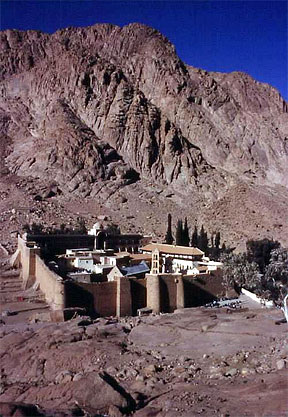 Yet in his instructions to the Israelites concerning altars, the Lord did not have them build a single altar at Sinai, as if this were some uniquely holy place. Rather, he commanded them to build altars “in every place” where he caused his name to be remembered (20:24). And the Lord promised to come and bless the Israelites in those places (20:24).
Yet in his instructions to the Israelites concerning altars, the Lord did not have them build a single altar at Sinai, as if this were some uniquely holy place. Rather, he commanded them to build altars “in every place” where he caused his name to be remembered (20:24). And the Lord promised to come and bless the Israelites in those places (20:24).
So Mt. Sinai was, on the one hand, one of the thinnest of thin places. Yet, on the other hand, it was not hallowed as a place that was somehow essentially thin. After the law was given at this location, we have no indication (to my knowledge) that Mt. Sinai continued to be a place of special prayer and pilgrimage for Jews. In time, of course, Jerusalem played that role. But, given what happened at Mt. Sinai, it is indeed striking that the place itself wasn’t regarded with awe as a unique place where one might encounter God. It wasn’t until several centuries after Christ that some Christians established St. Catherine’s Monastery at Mt. Sinai. (Photo: St. Catherine’s Monastery, with part of Mt. Sinai in the background.)
The sense we get from Exodus, at least to this point in the story, is that there can be thin places, but they don’t have to do with geography so much as God’s choice to make himself known there. After the time of revelation has passed, the former thin place retains none of its miraculous thinness.
Topics: Thin Places | 4 Comments »
The First Thin Place
By Mark D. Roberts | Tuesday, May 12, 2009
Part 2 of series: Thin Places
Permalink for this post / Permalink for this series
First, I want to thank those of you who have given feedback on this series, either through your comments or through emails to me. Your theological and experiential input has been very helpful. As always, I am terribly grateful for the content and spirit of your contributions.
Today I want to begin some theological reflection on the idea of thin places. As usual, I will get into the theological issues by examining relevant biblical passages. My question, at this point, is “How does Scripture lead us to think about the idea of thin places?”
In case you missed my first post in this series, let me explain once again that thin place is a metaphor with Celtic Christian origins. A thin place, in this tradition, is a place where human beings experience God more directly. The metaphor assumes a worldview in which heaven and earth are, in general, separated by a considerable distance. But some places on earth seem to be thin in the sense that the separation between heaven and earth is narrowed. Thus people sense God’s presence more readily in so-called thin places.
The metaphor of thin places does not appear in Scripture. That does not mean it’s unhelpful or theologically suspect. But those of us who base our theology on the Bible will want to consider this metaphor in light of biblical revelation.
As we begin to consider what Scripture has to say about thin places, we might well start at the beginning, in Genesis 1-3. There, we learn that God created heaven and earth, and that all of creation is good. We do not get the idea from these chapters that the world is divided up into godly places and ungodly places. There is no sanctifying of special spaces in the creation story. (There is, however, the setting aside of a special time, namely the seventh day. More on this later, I expect.)
 From the opening chapters of Genesis we don’t learn much about the interaction of the first humans with God. In chapter 3, we do see how God comes to look for Adam and Eve after they disobeyed him, and how they communicate directly with him. But, because of their disobedience, they are cast out of the Garden of Eden. This suggests that their access to God is not what it once was. To use the metaphor of this series, we might say that Eden was the first thin place, and that human beings were expelled from this place because of their sin. (Photo: A detail from a painting by Masaccio, “The Expulsion from the Garden of Eden,” 1426-1427.)
From the opening chapters of Genesis we don’t learn much about the interaction of the first humans with God. In chapter 3, we do see how God comes to look for Adam and Eve after they disobeyed him, and how they communicate directly with him. But, because of their disobedience, they are cast out of the Garden of Eden. This suggests that their access to God is not what it once was. To use the metaphor of this series, we might say that Eden was the first thin place, and that human beings were expelled from this place because of their sin. (Photo: A detail from a painting by Masaccio, “The Expulsion from the Garden of Eden,” 1426-1427.)
It would be mistaken, I believe, to think of Eden as the only thin place in the larger world. In fact, the Garden represents all of the created world. God’s purpose, it seems, was for all the world to be a thin place, a place where human beings experienced intimate and immediate fellowship with him. Eden represents the world before it was corrupted by sin, not a special place within the world where God is present.
Notice, however, what was to have happened in the Garden of Eden according to God’s plan. Here, human beings were to be fruitful and multiply, to take care of the earth and manage it well. Here, human beings were to till the Garden that God had planted. In a phrase, the first thin place was a place of work as well as rest. The man and the woman would experience God as they did what God created them to do.
I think this point is worth our attention because, for the most part, we tend to associate thin places with rest and retreat. Most thin places are far away from the noisy, busy, relentless demands of daily life. People call Laity Lodge a thin place, for example, because they experience God in a powerful way while on retreat there. Ditto for other sanctuaries throughout the world. But I don’t think I’ve ever heard anyone refer to his or her workplace as a thin place (not counting those of us who work at retreat centers!). Our thin places tend to be places of rest, quiet, prayer, worship, reflection, and peace . . . not places filled with colleagues, to-do lists, emails, fax machines, computers, cell phones, etc. etc. This doesn’t surprise me, but it does make me wonder about thin places and their relationship to our ordinary, workaday lives. If the first thin place, arguably the thinnest place of all, was a place where people worked, what difference might this make in the way we think about work, God, and even thin places, for that matter?
Topics: Thin Places | 3 Comments »
The Honor System at DFW
By Mark D. Roberts | Monday, May 11, 2009
Note: I’ll get back to my Thin Places series soon. Sorry for the delay.
 On a recent trip through the Dallas Fort Worth airport, I was surprised that they’re selling copies of USA Today on the honor system. The copies of the newspaper are sitting out where anyone can take them. A little sign says: “For Purchase Only – Please depost $1.00 in coin tube.” The so-called coin tube at the top of the stand was filled with dollar bills. (Should they call it the “bill tube”?)
On a recent trip through the Dallas Fort Worth airport, I was surprised that they’re selling copies of USA Today on the honor system. The copies of the newspaper are sitting out where anyone can take them. A little sign says: “For Purchase Only – Please depost $1.00 in coin tube.” The so-called coin tube at the top of the stand was filled with dollar bills. (Should they call it the “bill tube”?)
Although this newspaper stand was sitting outside of a Starbucks, nobody was monitoring it, as far as I could tell. I could easily have walked off with a free (well, okay, stolen) copy of USA Today.
I don’t know about you, but it does my heart good to see such a thing in today’s world. I have observed honor system sales in bookstores at retreat centers. In fact, we work on the honor system at Laity Lodge. But that’s in the middle of nowhere, far away from the crowds. The fact that people at DFW will pay for USA Today newspapers because it’s the right thing to do gladdens my heart.
Topics: Cultural Commentary | 1 Comment »
Sunday Inspiration from The High Calling
By Mark D. Roberts | Sunday, May 10, 2009
Feeding on God’s Abundance
How precious is your unfailing love, O God!
All humanity finds shelter
in the shadow of your wings.
You feed them from the abundance of your own house,
letting them drink from your river of delights.
When I was growing up in Glendale, California, I lived about a quarter-mile from my grandparents. In fact, their house was on my route home from school, and I often stopped in to visit them. Now, to be sure, I loved my grandparents and enjoyed their company. But I must confess that one reason I was such a regular guest had to do with food. They had plenty of it, including some of my favorite items. My grandmother was always sure to have an abundance of ice cream and Doritos. I don’t think these items helped me to be healthier, but they surely made my life happier. I will never forget the joy of sitting in my grandparents’ breakfast room, feasting on the abundance of their house and enjoying their company.
Psalm 36:7-8 uses a similar image to speak of how God feeds us “from the abundance of [his] own house.” Notice that the “us” in this case is not only God’s chosen people. Rather, “all humanity” receives the blessing of God’s goodness.
If you were to read the original Hebrew of verse 8, you might be surprised by what you found. Where our English says, “You feed them from the abundance of your own house,” the original language reads, “They are satiated from the fat of your house.” In the world of ancient Israel, fat was associated with feasting, even with celebrations in the temple. God feeds us, not only with real food that is delicious, but with the even tastier joys of his presence. He wants our relationship with him to be something wonderful, not just something we have to do because it’s right. In the words of the Westminster Shorter Catechism, our chief purpose in life is to “glorify God and enjoy him forever.” In more poetic language, we feast from the “fat” of his house and drink from his “river of delights.”
QUESTIONS FOR REFLECTION: When have you feasted from the abundance of God’s house? How can we participate in this feast on a regular basis? When do you enjoy God the most?
PRAYER: Thank you, gracious God, for inviting me to feed “from the abundance of your own house.” Thank you for “stocking your shelves” with that which I love to eat. I know, Lord, that I should want to be with you simply for fellowship. But the fact that you bless me so richly draws me to you, rather like ice cream and Doritos.
Dear Lord, teach me to feed regularly from your abundance. Help me to visit you often, to spend time with you, to sample your delights.
All praise be to you, God of abundance, for your innumerable gifts to me. Amen.
Photo: My grandparents and me in around 1985.
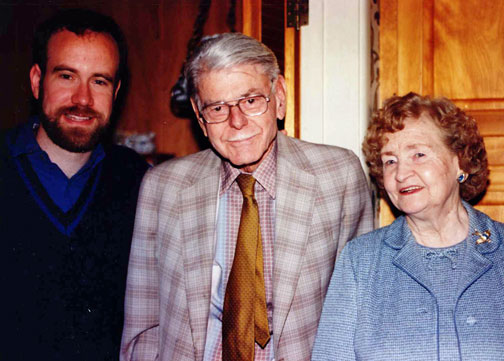
_________________________________________________
 Would you like to receive a Daily Reflection like this one in your email inbox each morning?
Would you like to receive a Daily Reflection like this one in your email inbox each morning?
Here’s how . . . .
This devotional comes from The High Calling of Our Daily Work (www.thehighcalling.org). You can read my Daily Reflections there, or sign up to have them sent to your email inbox each day. This website contains lots of encouragement for people who are trying to live out their faith in the workplace.
Topics: Sunday Inspiration | 1 Comment »
McKnight, Ford, and Now Avery: Déjà Vu All Over Again!
By Mark D. Roberts | Saturday, May 9, 2009
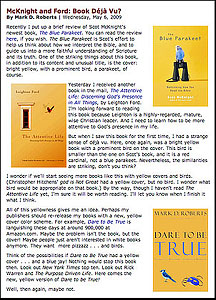 Well, sometimes life is strange, full of concidences, if not conspiracies. I’ve stumbled into just such an odd situation. It’s very peculiar . . . curious!
Well, sometimes life is strange, full of concidences, if not conspiracies. I’ve stumbled into just such an odd situation. It’s very peculiar . . . curious!
Last Wednesday I put up a rather silly blog post about book covers (see photo to right). I noted that two recent books, one by Scot McKnight and one by Leighton Ford, had very similar covers. Both were yellow, adorned by birds. I wondered out loud if my books would sell better with yellow covers featuring birds. But that was all tongue in cheek.
Then, on Thursday I received a catalog from the jewelry company James Avery. (Well, to be more accurate, my wife received the catalog.) I couldn’t believe the cover. It was yellow, with a prominent butterfly. Okay, okay, it’s not a bird. But it is a flying beast on a yellow background. What is up with this?  Is there some yellow-cover conspiracy of which I am unaware? Did everybody get together and decide that yellow plus flying things were “in”? Why wasn’t I invited? Did they invite you? You’ll have to admit this is all pretty strange.
Is there some yellow-cover conspiracy of which I am unaware? Did everybody get together and decide that yellow plus flying things were “in”? Why wasn’t I invited? Did they invite you? You’ll have to admit this is all pretty strange.
So, keep your eyes open for yellow-covered printed material featuring flying fauna. And if you’re trying to see your stuff, think about this schema. Somebody out there thinks it will work.
Topics: Strange But True | 3 Comments »
Your “Thin Places”?
By Mark D. Roberts | Friday, May 8, 2009
First of all, I want to thank those of you who commented on yesterday’s introductory post. I appreciate your honesty and insights. I also like the respectful disagreement among commentators. You’ve give us all lots to think about. (If you missed yesterday’s comments, you can find them here.)
Before I go further in this series, I’d like to hear from you about your “thin places.” Where have you encountered God in an especially powerful way? Did the place have anything to do with your experience? Have other people experienced God’s presence in the same place? If so, why? Other than the presence of God, are there things that make a thin place thin? (Photo below: Laity Lodge as a “thin place”?)

Then I have some theological questions. Do you think God chooses to make himself known in an unusual way in special places (call them “thin” or not)? Why? Or why not? Do you see any theological advantages or disadvantages in the phrase “thin place”?
You can anwer these questions as comments, or you can email me. I look forward to your input. Thanks in advance.
Topics: Thin Places | 9 Comments »
Thin Places: An Introduction
By Mark D. Roberts | Thursday, May 7, 2009
Part 1 of series: Thin Places
Permalink for this post / Permalink for this series
I first heard someone use the phrase “thin place” about fifteen years ago. She had become a devotee of Celtic spirituality, from which source she had discovered the label “thin place.” She was terribly enthusiastic about the idea of “thin places,” and proceeded to use this phrase to excess, which didn’t add to my enthusiasm for the phrase. Nevertheless, she got me thinking about thin places for the first time.
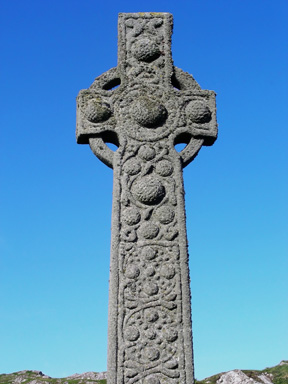 Celtic spirituality, by the way, has nothing to do with Boston’s basketball team. The word “Celtic” (pronounced KEL-tik, in this case) refers to a variety of Christian devotion practiced in Ireland and Scotland since the fifth century A.D. In recent years, there has been a revival of interest in Celtic spirituality, partly because of the popularity of Celtic religious art, and partly because of the wide influence of the Iona Community, a Christian community on the Scottish island of, you guessed it, Iona. (Photo: A Celtic cross on the island of Iona.)
Celtic spirituality, by the way, has nothing to do with Boston’s basketball team. The word “Celtic” (pronounced KEL-tik, in this case) refers to a variety of Christian devotion practiced in Ireland and Scotland since the fifth century A.D. In recent years, there has been a revival of interest in Celtic spirituality, partly because of the popularity of Celtic religious art, and partly because of the wide influence of the Iona Community, a Christian community on the Scottish island of, you guessed it, Iona. (Photo: A Celtic cross on the island of Iona.)
The woman who introduced me to the phrase “thin place” explained its meaning. “A thin place,” she said, “is a place where the boundary between heaven and earth is especially thin. It’s a place where we can sense the divine more readily.” I wondered why this person, a respected Christian leader, seemed to have a hard time speaking of relationship with God. “Thin place” almost functioned as a circumlocution, a way getting around actually saying “God is especially present here.” I also wondered about the whole idea of thin places. Are there such places? If so, why are they thin? Something about the whole notion of thin places made me nervous, theologically speaking, but I couldn’t quite put my finger on the problem.
Since my first exposure to the phrase “thin place,” I’ve probably heard it used five hundred times, maybe more. In certain Christian circles, Celtic Christianity has become wildly popular, and so has the use of “thin place” to describe places where people experience God (or “the divine,” if you prefer). I have tended to resist this language, partly because of its trendy overuse, and partly because of my nagging discomfort about its meaning.
Well, in the irony of God’s sovereignty, I’ve ended up in a place that people love to identify as thin. In my eighteen months as Senior Director of Laity Lodge, I’ve heard Laity Lodge described as a thin place probably a hundred times or more. When people say this, they mean to compliment Laity Lodge as an unusual place that fosters intimacy with God. For them, the barrier between earth and heaven does seem to become very thin at Laity Lodge. They have experienced God with more immediacy and intimacy when on retreat in the Frio River canyon than in their ordinary lives. In many cases, people have had life-transforming experiences at Laity Lodge through the presence and power of God’s Spirit.
Beginning today, I want to reflect a bit on the notion of thin places (sometimes called thin spaces). I’m not starting this blog series with a clear sense of where I’m headed. And I’m not planning to grind any particular axe. Rather, I want to think about the idea of thin places, especially in light of Scripture. I want to consider what makes a place thin, and how this description might be helpful (or not).
As always I’m interested in your comments. What do you think of the language of “thin places”? Have you ever experienced something you might call a thin place? Where? What happened?
Stay tuned . . . .
Topics: Thin Places | 21 Comments »
McKnight and Ford: Book Déjà Vu?
By Mark D. Roberts | Wednesday, May 6, 2009
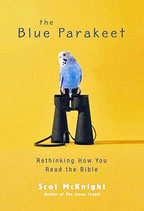 Recently I put up a brief review of Scot McKnight’s newest book, The Blue Parakeet. You can read the review here, if you wish. The Blue Parakeet is Scot’s effort to help us think about how we interpret the Bible, and to guide us into a more faithful understanding of Scripture and its truth. One of the striking things about this book, in addition to its content and unusual title, is the cover: bright yellow, with a prominent bird, a parakeet, of course.
Recently I put up a brief review of Scot McKnight’s newest book, The Blue Parakeet. You can read the review here, if you wish. The Blue Parakeet is Scot’s effort to help us think about how we interpret the Bible, and to guide us into a more faithful understanding of Scripture and its truth. One of the striking things about this book, in addition to its content and unusual title, is the cover: bright yellow, with a prominent bird, a parakeet, of course.
 Yesterday I received another book in the mail, The Attentive Life: Discerning God’s Presence in All Things, by Leighton Ford. I’m looking forward to reading this book because Leighton is a highly-regarded, mature, wise Christian leader. And I need to learn how to be more attentive to God’s presence in my life.
Yesterday I received another book in the mail, The Attentive Life: Discerning God’s Presence in All Things, by Leighton Ford. I’m looking forward to reading this book because Leighton is a highly-regarded, mature, wise Christian leader. And I need to learn how to be more attentive to God’s presence in my life.
But when I saw this book for the first time, I had a strange sense of déjà vu. Here, once again, was a bright yellow book with a prominent bird on the cover. This bird is smaller than the one on Scot’s book, and it is a red cardinal, not a blue parakeet. Nevertheless, the similarities are striking, don’t you think?
I wonder if we’ll start seeing more books like this with yellow covers and birds. (Christopher Hitchens’ god is Not Great had a yellow cover, but no bird. I wonder what bird would be appropriate on that book.) By the way, though I haven’t read The Attentive Life yet, I’m sure it will be worth reading. I’ll let you know when I finish it what I think.
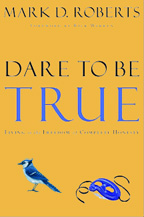 All of this yellowness gives me an idea. Perhaps my publishers should re-release my books with a new, yellow cover color scheme. For example, Dare to Be True is languishing these days at around 900,000 at Amazon.com. Maybe the problem isn’t the book, but the cover! Maybe people just aren’t interested in white books anymore. They want more pizzazz . . . and birds.
All of this yellowness gives me an idea. Perhaps my publishers should re-release my books with a new, yellow cover color scheme. For example, Dare to Be True is languishing these days at around 900,000 at Amazon.com. Maybe the problem isn’t the book, but the cover! Maybe people just aren’t interested in white books anymore. They want more pizzazz . . . and birds.
Think of the possibilities if Dare to Be True had a yellow cover . . . and a blue jay! Nothing would stop this book then. Look out New York Times top ten. Look out Rick Warren and The Purpose Driven Life. Here comes the new, yellow version of Dare to be True!
Well, then again, maybe not.
Topics: Book Reviews | 2 Comments »
Retreat as Practice
By Mark D. Roberts | Tuesday, May 5, 2009
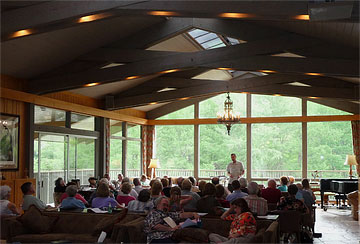 This past weekend we at Laity Lodge were pleased to host a group from Chapelwood United Methodist Church in Houston, Texas. This large, vibrant church hosts a wide array of ministries, including The Center for Christian Spirituality. The director of this center is Jerry Webber, who spoke for the Chapelwood retreat. (Photo: Jerry teaching in the Great Hall, facing the Frio River.)
This past weekend we at Laity Lodge were pleased to host a group from Chapelwood United Methodist Church in Houston, Texas. This large, vibrant church hosts a wide array of ministries, including The Center for Christian Spirituality. The director of this center is Jerry Webber, who spoke for the Chapelwood retreat. (Photo: Jerry teaching in the Great Hall, facing the Frio River.)
Jerry, who is an experienced retreat leader, did a fine job as teacher and leader of the retreat. I was especially appreciative of his creative use of the Psalms and other poetry. His biblical teaching was rock solid, though Jerry is more of a reflector on Scripture than an expositor. Yet it was obvious to me that he had done his expositional homework, so that his reflections were faithful to the Bible.
Jerry said many things that I will remember, but one struck me with particular impact. “Retreat is practice,” he said. “We retreat in order to practice being more attentive to God, so that when we get back to our daily lives, we can pay better attention to God.” What a great way of capturing the power of retreat! We often think of retreats as getting away from ordinary life in order to rest and be refreshed. Such renewal surely helps us to live more fully in our normal lives. But the notion of practice adds a different dimension. When we’re in a place of quiet, when the pace slows down, when we are intentionally still, we are able to listen more carefully to the still, small voice of the Spirit. This kind of attentiveness is hard to sustain in the midst of our day-to-day living. But retreat can help us practice so that we can live better lives when we’re not on retreat.
The founder of Laity Lodge, Howard E. Butt, Jr., has often said that we “retreat to advance.” The retreat is not the end or purpose. We don’t retreat merely to have a mountaintop experience (or canyon-bottom, as in the case of Laity Lodge). Rather, a retreat should help us, in some small way, or maybe in a giant one, to live more purposefully, more completely, and, indeed, more attentively.
Retreat is a way of practicing so we can live better. Do you need a retreat?
Topics: Sharing Laity Lodge | No Comments »
Newsweek: “Is That a Bible in Your Pocket?”
By Mark D. Roberts | Monday, May 4, 2009
This week’s edition of Newsweek (May 4, 2009) includes an article called: “Is That a Bible in Your Pocket?” Lisa Miller, Newsweek’s religion editor, comments on the growing popularity of holy writ iPhone apps. Apparently, some of the most popular apps for the iPhone are versions of the Bible, the Qur’an, and so on.
Miller asks if it’s a good thing to read one’s Scripture on a cell phone, for if this is an intrusion of the technological into the spiritual realm. It seems that, in the end, Miller see advantages to having a copy of the Bible “next to your calorie counter and your Global Positioning System,” since this helps to “integrate religious practice with the rest of your life.” She continues:
In the modern West, “sacredness has become this ‘other’,” says Anne Foerst, professor of theology and computer science at St. Bonaventure University. “I find that problematic. Sacredness touches our lives constantly in the here and now. It enters what we call trivial and transcends it.” Religious apps may seem to represent modernity run amok, in other words, but they can bring holiness back into our lives where it belongs.
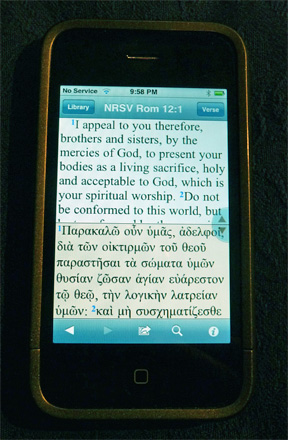 I agree with Miller’s conclusion here, though with some reservations. In fact, I have five Bible versions on my iPhone (NRSV, ESV, NLT, Greek NT, Hebrew OT). I love being able to carry around these texts in my pocket. In fact, my Bible app (published by Olive Tree), offers a split screen version, so I can have an English translation and an original language version showing at the same time.
I agree with Miller’s conclusion here, though with some reservations. In fact, I have five Bible versions on my iPhone (NRSV, ESV, NLT, Greek NT, Hebrew OT). I love being able to carry around these texts in my pocket. In fact, my Bible app (published by Olive Tree), offers a split screen version, so I can have an English translation and an original language version showing at the same time.
My reservations about having the Bible on my iPhone have to do with temptations that come with using an iPhone in church. If I’m checking a biblical passage during a sermon, I just might sneak a peek at the news, especially if the sermon’s boring. I won’t admit in such a public place whether I’ve actually done that or not. But, suffice it to say that I’d be better off putting my phone in Airplane Mode while in a worship service. (For those of you who are not iPhone users, Airplane Mode allows me to have my iPhone on, but without any phone or Internet service.)
Nevertheless, I do like the idea that my Bible lives in the same world as my calendar, my daily news sources, and my to-do list. This fact helps to dismantle the sacred-secular distinction that keeps so many Christians from living as disciples of Jesus every moment of every day.
Topics: Thoughts | 5 Comments »
Sunday Inspiration from The High Calling
By Mark D. Roberts | Sunday, May 3, 2009
Play Skillfully
Sing a new song of praise to him;
play skillfully on the harp, and sing with joy.
The Hebrew expression translated here as “play skillfully” literally means “to do well in playing music.” The verb “to be skillful” comes from the Hebrew root that means “good,” and is elsewhere translated as “to do well.” But when it’s combined with the verb for playing instruments, the “to do well” suggests musical expertise.
Psalm 33:3 reminds us that we’re to use well the gifts God has given us. If we have musical talent, then we should learn to “play skillfully” for the Lord. In reality, this takes years of diligent practice. Though it might be tempting for people with lots of natural musical ability to coast on their laurels, Psalm 33 encourages them to work hard on developing their skills. Yet their commitment to excellence must not keep them from singing “with joy” (v. 3).
By analogy, all of us should “play skillfully” in the areas in which we have been given talents from God. If you have a precise mind and a facility with numbers, excel as an accountant . . . to the glory of God. If you are a creative communicator with a passion for young people, be the best teacher you can be . . . to the glory of God. If you are a visionary who can move people to purposeful action . . . be a fine leader, to the glory of God.
But as you seek to serve the Lord with excellence, don’t forget about joy. As you offer yourself and your talents to God, delight in being able to use what he has given you for his pleasure and glory.
QUESTIONS FOR REFLECTION: In what areas of life do you “play skillfully”? How might you offer all that you do to the Lord? When do you experience the combination of excellence and joy?
PRAYER: Dear Lord, first of all, I want to thank you for the gift of music, for those who have worked hard to play skillfully for you, and for the ability to hear and delight in music.
I also want to thank you, Lord, for the talents you have given me. Help me to develop them intentionally, to use them faithfully for your glory. Though I won’t be playing skillfully for you on a harp, may I “play skillfully” the instruments you have given me.
May this be true, dear Lord, for all of your people. Help us to be faithful stewards of the talents and gifts you have given. May we “play skillfully” at work, in our communities, as we serve at church, in our families, and in every other facet of life. Amen.
_________________________________________________
 Would you like to receive a Daily Reflection like this one in your email inbox each morning?
Would you like to receive a Daily Reflection like this one in your email inbox each morning?
Here’s how . . . .
This devotional comes from The High Calling of Our Daily Work (www.thehighcalling.org). You can read my Daily Reflections there, or sign up to have them sent to your email inbox each day. This website contains lots of encouragement for people who are trying to live out their faith in the workplace.
Topics: Sunday Inspiration | No Comments »
A Hidden Mickey at Laity Lodge
By Mark D. Roberts | Saturday, May 2, 2009
Recently I found an unexpected surprise . . . a Hidden Mickey at Laity Lodge.
 “What is a Hidden Mickey?” you ask. If you’re a fan of Walt Disney lore, you probably know the answer. But if not, let me explain (or you can read more here). A Hidden Mickey is a group of three circular objects that looks like the head of Mickey Mouse, more or less. Hidden Mickeys are placed in Disney media, usually in their theme parks, by Disney employees (often Imagineers, the creative geniuses who design the theme parks). Some of the Hidden Mickeys are quite obvious, such as the configuration of plates in the banquet scene of the Haunted Mansion at Disneyland. I have seen this one. It is easy to spot and most certainly a true Hidden Mickey. (Photo: Hidden Mickey from plates in the Haunted Mansion.)
“What is a Hidden Mickey?” you ask. If you’re a fan of Walt Disney lore, you probably know the answer. But if not, let me explain (or you can read more here). A Hidden Mickey is a group of three circular objects that looks like the head of Mickey Mouse, more or less. Hidden Mickeys are placed in Disney media, usually in their theme parks, by Disney employees (often Imagineers, the creative geniuses who design the theme parks). Some of the Hidden Mickeys are quite obvious, such as the configuration of plates in the banquet scene of the Haunted Mansion at Disneyland. I have seen this one. It is easy to spot and most certainly a true Hidden Mickey. (Photo: Hidden Mickey from plates in the Haunted Mansion.)
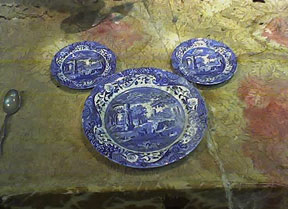 Some folks are quite “into” Hidden Mickeys. They look for them endlessly, sometimes seeing them when they’re not really there. But several websites (for example, hiddenmickeys.org) try to collect and verify sightings. When I’m at a Disney theme park, I like looking for Hidden Mickeys, and have seen a few, but haven’t discovered any.
Some folks are quite “into” Hidden Mickeys. They look for them endlessly, sometimes seeing them when they’re not really there. But several websites (for example, hiddenmickeys.org) try to collect and verify sightings. When I’m at a Disney theme park, I like looking for Hidden Mickeys, and have seen a few, but haven’t discovered any.
Last week I did discover a Hidden Mickey,however. It wasn’t at a Disney theme park, or in some other Disney product. Rather, it was growing naturally on the H.E. Butt Foundation property of which Laity Lodge is a part. I was hiking about a half-mile from Laity Lodge when, lo and behold, I saw this!
I did not doctor this photo in any way. It is, truly, a miracle, proof that God also a fan of Hidden Mickeys. Or, well, maybe not . . . .
Topics: Fun | 4 Comments »
Highly Recommended: National Worship Leader Conference 2009
By Mark D. Roberts | Friday, May 1, 2009
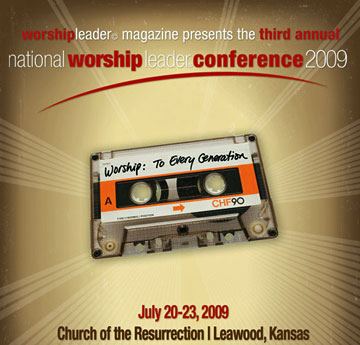 If you’re a worship leader, a pastor, or a lay person who cares about the worship life of your church, I highly recommend the National Worhsip Leader Conference 2009.
If you’re a worship leader, a pastor, or a lay person who cares about the worship life of your church, I highly recommend the National Worhsip Leader Conference 2009.
Let me say up front that I am involved with this conference as one of the workshop presenters. It is sponsored by Worship Leader magazine, for whom I write a regular column. So I do have a vested interest in this conference. But my partnership with Worship Leader reflects my excitement of their vision as well as the quality of what they do (publishing, conferences, etc.). Last year’s NWL Conference was outstanding.
But my excitement for the NWL Conference reflects my enthusiasm for its content. No matter your particular form of worship, no matter whether you’re denominational or independent, no matter your particular role in worship leadership, this conference has something for you. Just check out the list of workshops and you’ll see what I mean.
Then there’s the collection of resource people. Here are just a few of those who will be leading and teaching at the NWL Conference: Michael W. Smith, Greg Laurie, the David Crowder Band, Marva Dawn, Tommy Walker, Todd Hunter, and Reggie Kidd. Honestly, I feel privileged to be part of such an incredible team of worship leaders and teachers.
The NWL Conference happens on July 20-23, 2009 at the Church of the Resurrection in Leawood, Kansas. It’s fairly close to the Kansas City International Airport, which is just about in the center of the United States. (To be specific, Leawood is 200 miles from Lebanon, Kansas, the actual center of the contiguous United States.)
Maybe you’re not a worship leader or a pastor or someone involved in the worship ministry of a church. Let me suggest that you consider giving a gift of this conference to your worship leader. Or perhaps you have a young, up-and-coming worship leader in your congregation. Why not get a few friends together and send him or her to this conference? I promise that you will not be disappointed.
Topics: Recommendations | 1 Comment »




